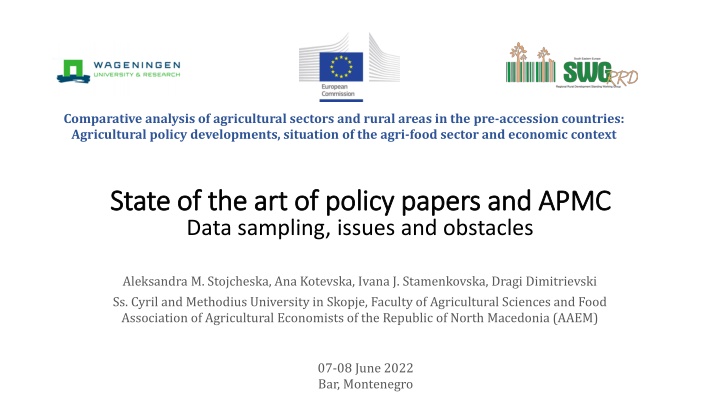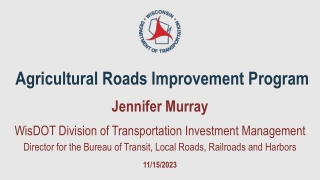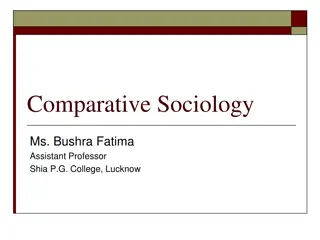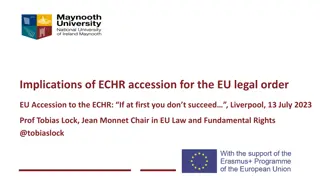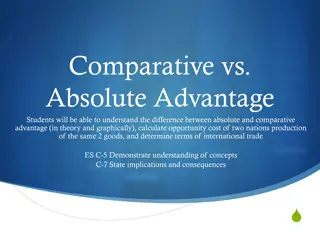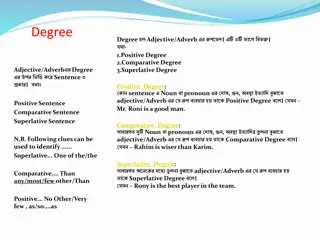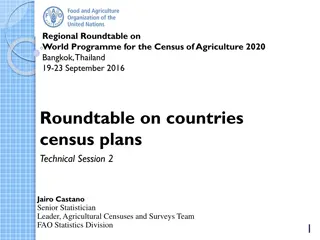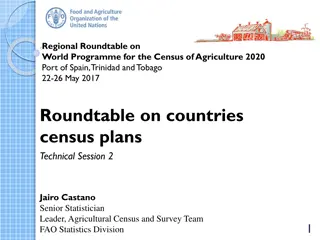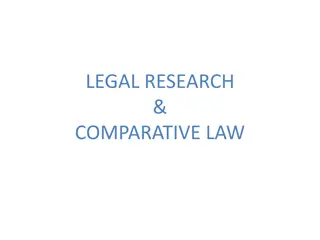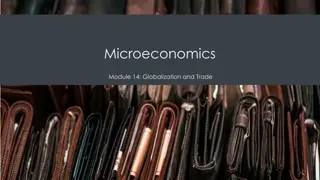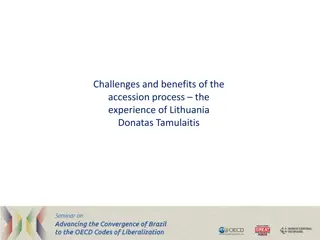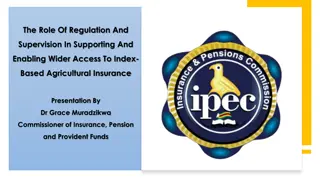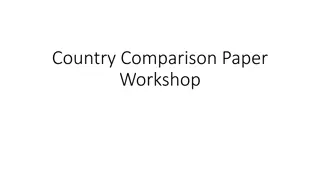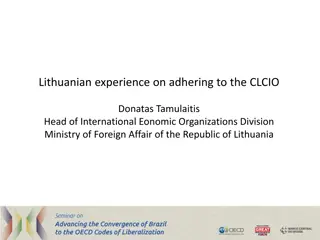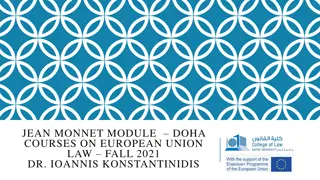Comparative Analysis of Agricultural Sectors in Pre-Accession Countries
Agricultural policy developments in pre-accession countries are analyzed with a focus on the agri-food sector, economic context, and policy papers. The study includes country case studies, data sampling, and analysis of obstacles in the agricultural sector.
Download Presentation

Please find below an Image/Link to download the presentation.
The content on the website is provided AS IS for your information and personal use only. It may not be sold, licensed, or shared on other websites without obtaining consent from the author.If you encounter any issues during the download, it is possible that the publisher has removed the file from their server.
You are allowed to download the files provided on this website for personal or commercial use, subject to the condition that they are used lawfully. All files are the property of their respective owners.
The content on the website is provided AS IS for your information and personal use only. It may not be sold, licensed, or shared on other websites without obtaining consent from the author.
E N D
Presentation Transcript
Comparative analysis of agricultural sectors and rural areas in the pre-accession countries: Agricultural policy developments, situation of the agri-food sector and economic context State of the art of policy papers and APMC State of the art of policy papers and APMC Data sampling, issues and obstacles Aleksandra M. Stojcheska, Ana Kotevska, Ivana J. Stamenkovska, Dragi Dimitrievski Ss. Cyril and Methodius University in Skopje, Faculty of Agricultural Sciences and Food Association of Agricultural Economists of the Republic of North Macedonia (AAEM) 07-08 June 2022 Bar, Montenegro
Outline Agricultural policy developments in WBCs and TR 2020-2021 First drafts checking methodology Input provided by NEs (so far) Overview of preliminary findings, with emphasis on missing data Further steps
Country case studies Provide overview of the state-of-affairs in the country s agricultural policy, with focus on the recent developments in 2020 and 2021; Collect agricultural policy data in the country/territory from relevant national policy documents and legislation, with focus on the recent developments in 2020 and 2021; Provide an overview of the institutional/administrative policy framework; Review the policy milestones, policy strategic documents and operational framework of national policies, and elaborate on the future development of national policies in the country/territory; Provide an overview of the Covid-19 related agricultural policy interventions and implications; Identify the country s policy objectives, instruments and measures addressing the need for greener policy in view of the growing challenges related to climate change, biodiversity loss and management of natural resources; Provide an overview of the existing policy framework to evaluate compliance with EU standards in primary production and processing and state of harmonisation with the EU CAP (including the EU Green Deal Farm to Fork Strategy); Include expert assessment of the country s agricultural policy framework, conclusions and recommendations. The country report will also provide background for the cross-country comparative analysis of the agricultural policy developments in the WB countries and Turkey.
Method and materials Quantitative methods: Update the country s APMC database for the years 2020 and 2021, to enable systematic and standardized evaluation and hence comparative basis among the countries. Provide several additional statistics to enable calculation of policy related indicators (e.g. population, UAA, GDP, agricultural output value etc.), for which an Excel sheet will be provided by the Regional coordinator. Mark the measures linked to greener policy in the APMC database (e.g. climate change, biodiversity loss and management of natural resources). Mark the measures linked to Covid-19 intervention in the APMC database.
Method and materials Qualitative methods: Analysis of agricultural and rural development policy documents, through literature review of formal policy documents, research studies, expert papers, personal communications. Input from the key players in the governmental structures (interviews). Expert assessment of the national developments and comparative analysis with the EU CAP framework.
Method and materials Sources of data: National systems for monitoring budgetary spending by individual agricultural policy measure Governmental budgetary plans Policy programs and regulations Reports on the implementation of agricultural policy measures from various ministries Aggregate budgetary data from the ministry of finance Local level authorities International donors Other sources - statistical offices, EC country progress reports etc.
Country case studies - structure 1. Agricultural policy framework in the country/teritory 2. Measures and budgetary support of agriculture and rural development 3. Covid-19 interventions in policy and implications 4. Greener policy instruments and measures linked to climate change, biodiversity loss and management of natural resources 5. EU approximation process 6. Conclusions and policy recommendations
First drafts checking method APMC: Completeness, Consistency, Continuity Model functionality Graphic representation (updated) Country reports: Completeness Contents first reading
Input provided (so far): Covid-19 row Green Additional stats Ag. land GVA, employed part.miss. 2021 APMC Report measures row * AL 1st draft BA 1st draft not yet XK Partial (announced) not yet not yet * MK 1st draft ME Planned amounts not yet not yet not yet miss. 2021 RS 1st draft TR 1st draft Some revision needed * No C19 separate measures
Comparative cross-country analysis From the collected country information, APMCs and case studies: Comparative cross-country analysis of the agricultural policy developments in the WB countries/territories and Turkey Main successes and failures of agricultural policies EU approximation process of the WB countries/territories and Turkey Policy recommendations Country and cross-country harmonised and consistent database (internal and public)
Comparative cross-country analysis Preliminary contents: Executive summary Introduction Materials and methods Agricultural policy framework in the WB countries and Turkey Measures and budgetary support of agriculture and rural development in the WB countries and Turkey Covid-19 interventions in policy and implications Greener policy instruments and measures linked to climate change, biodiversity loss and management of natural resources EU approximation process Conclusions and policy recommendations
Agricultural policy framework meet upon their accession: developing ability to take on the obligations of the EU membership, strong reliable management and control systems to align with the EU legal, administrative set-up, support system to facilitate integration of the agricultural sector into the EU single market and political decision-making process Most countries/teritories have adopted or are in the final stage of adopting new strategic documents for the period 2021-2027 (national and IPARD III) Ag. policy strategic planning/policy cycle, administrative capacity, monitoring and evaluation, analytical support for policy formation and implementation WB level Preliminary overall assessment of the strategic policy framework: initial stage (AL, BA, XK, ME) and initial to medium stage (MK, RS). EU accession - key political goal EU s CAP represents the benchmark for agricultural policies in pre-accession countries to
EU progress WBs and TR (2019 vs 2021) Acquis Chapter Year (11) Agriculture & Rural Development 2019 Some level of preparation* (12) Food Safety, Veterinary & Phytosanitary Policy 2019 Some level of preparation* Some level of preparation Some level of preparation Moderately prepared*** Good level of preparation Moderately prepared** Some level of preparation*** (13) Fisheries 2021 2021 2019 2021 Some level of preparation* Some level of preparation* Some level of preparation Some level of preparation Moderately prepared*** Good level of preparation Moderately prepared** Some level of preparation*** Some level of preparation* AL Early stage* BA Early stage Early stage Early stage Early stage Some level of preparation Moderately prepared*** Moderately prepared Some level of preparation** Some level of preparation**** Some level of preparation Moderately prepared*** Moderately prepared Some level of preparation** Some level of preparation**** XK Early stage Early stage Some level of preparation*** ME Early stage*** Moderately prepared Moderately prepared*** Moderately prepared Moderately prepared*** Some level of preparation**** MK RS TR Early stage**** *Screening started; ** Screening completed; *** Chapter opened; ****Chapter opened/frozen
Total budgetary support to agriculture 60 140 90 XS Other measures related to agriculture 100 BA Other measures related to agriculture 70 AL 80 120 50 40 60 80 50 Structural and rural development measures 40 Structural and rural development measures 30 30 40 60 20 20 10 20 Market and direct producer support measures 0 12 Market and direct producer support measures 12 10 0 0 12 13 14 15 16 17 18 19 20 21 13 14 15 16 17 18 19 20 21 13 14 15 16 17 18 19 20 21 180 60 400 Other measures related to agriculture MK Other measures related to agriculture 140 Other measures related to agriculture 350 RS ME 160 50 300 40 120 250 Structural and rural development measures 100 Structural and rural development measures 60 Structural and rural development measures 150 30 200 80 20 100 40 10 Market and direct producer support measures Market and direct producer support measures 0 12 Market and direct producer support measures 0 12 50 20 0 12 13 14 15 16 17 18 19 20 21 13 14 15 16 17 18 19 20 21 13 14 15 16 17 18 19 20 21 Attention: different scales
Structure of budgetary transfers 11% 6% 100% 15% 300 14 5 5 3 22% 22% 32 4 9 19 80% 50% 55 57% 30 85% 60% 11 2489 94% 89% (2017-19) 85% 75 24 108 78% 78% 40% 188 50% 29 43% 20% 8 Legend: 15% 4 0% Market and direct producer support measures; Structural and rural development measures; Other measures to agriculture AL BA XK ME MK RS TR AL BA XK ME MK RS TR EU 28 Total Budgetary Support to Agriculture, in % and mill. EUR MDP/SRD ratio 13% 100% 16% 18% 12 0 12 32 23% 6 10 7 14 25 77 80% 73% 78% 64,077 60% (2020-21) 96% 29 31 87% 84% 82% 66 77% 94 115 40% 266 20% 27% 22% 11 2,503 TR 9 4% TR 0% AL BA XK ME MK RS AL BA XK ME MK RS
Structural and rural development measures Budgetary support, in mill. EUR AL BA XK ME* MK RS 17-19 20-21 17-19 20-21 17-19 20-21 17-19 20-21 17-19 20-21 17-19 20-21 24.29 29.55 4.57 13.55 26.60 8.29 25.92 11.33 19.25 50.79 60.15 Improving the competitiveness of agro-food sector 2.18 5.50 3.70 11.95 21.34 7.80 24.85 4.50 5.30 49.27 58.38 On-farm investment and restructuring support 19.32 22.35 0.25 0.45 1.80 0.08 0.14 5.00 11.05 1.49 1.74 Agricultural infrastructure 2.79 1.75 0.62 1.15 3.46 0.41 0.94 1.87 2.85 0.02 0.02 Off-farm storage, processing, marketing and promotion - 0.08 0.25 0.08 0.51 0.73 2.03 3.25 1.84 3.85 Providing environmental and societal benefits Payments to farmers in areas with natural & environmental constraints Agro-environment, organic and animal welfare payments to farmers - 0.04 0.05 - - - 0.90 2.90 - - - 0.06 0.15 0.08 0.51 0.73 1.43 1.75 1.84 3.85 - - - - - - - - - - Other ecosystem related payments 0.27 1.10 0.39 0.55 2.94 1.98 2.31 4.00 2.20 4.04 13.29 Supporting rural economy and population Creation and development of non-agricultural activities in rural areas Rural infrastructure, basic services and village development 0.27 1.10 - 0.00 1.21 - - 0.10 1.45 - - - - 0.39 0.55 1.51 1.98 2.31 4.00 0.70 4.04 13.24 - - - 0.22 - - - 0.05 0.01 0.05 Building local capacity (LEADER) 24.55 30.70 5.09 14.45 29.61 n/a 10.77 28.96 17.43 24.70 56.68 77.29 STRUCTURAL AND RURAL DEVELOPMENT MEASURES
Structural and rural development measures Budgetary support, in mill. EUR AL BA XK ME* MK RS 17-19 20-21 17-19 20-21 17-19 20-21 17-19 20-21 17-19 20-21 17-19 20-21 24.29 29.55 4.57 13.55 26.60 8.29 25.92 11.33 19.25 50.79 60.15 Improving the competitiveness of agro-food sector 2.18 5.50 3.70 11.95 21.34 7.80 24.85 4.50 5.30 49.27 58.38 On-farm investment and restructuring support 19.32 22.35 0.25 0.45 1.80 0.08 0.14 5.00 11.05 1.49 1.74 Agricultural infrastructure 2.79 1.75 0.62 1.15 3.46 0.41 0.94 1.87 2.85 0.02 0.02 Off-farm storage, processing, marketing and promotion - - 0.08 0.25 0.08 0.51 0.73 2.03 3.25 1.84 3.85 Providing environmental and societal benefits Payments to farmers in areas with natural & environmental constraints Agro-environment, organic and animal welfare payments to farmers - - 0.04 0.05 - - 0.90 2.90 - - - - 0.06 0.15 0.08 0.51 0.73 1.43 1.75 1.84 3.85 - - - - - - - - Other ecosystem related payments 0.27 1.10 0.39 0.55 2.94 1.98 2.31 4.00 2.20 4.04 13.29 Supporting rural economy and population Creation and development of non-agricultural activities in rural areas Rural infrastructure, basic services and village development 0.27 1.10 0.00 1.21 - 0.10 1.45 - - 0.39 0.55 1.51 1.98 2.31 4.00 0.70 4.04 13.24 0.22 - - - - 0.05 0.01 0.05 Building local capacity (LEADER) 24.55 30.70 5.09 14.45 29.61 n/a 10.77 28.96 17.43 24.70 56.68 77.29 STRUCTURAL AND RURAL DEVELOPMENT MEASURES
IPARD II (2014-2020) programme funding Approved funds, in mill. EUR AL ME* MK RS TR** Used national contribution 17.73 6.21 19.73 22.10 119.40 Used EU part 53.20 18.62 59.34 66.00 359.40 Total used funds 70.93 24.83 79.07 88.10 478.80 Remaining EU funds 71.00 39.00 60.00 175.00 801.00 Funds approved, % 75% 48% 99% 38% 45% *ME old data; **TR to be checked (lower values in 2021)
Operational IPARD II (2014-2020) measures AL ME MK RS TR M1: "Investments in physical assets of agricultural holdings" M3: "Investments in physical assets concerning processing and marketing of agricultural and fishery products" M4: "Agri-environment, climate and organic farming (pilot on soil erosion)" M5: "Implementation of local development strategies LEADER approach" M7: "Farm diversification and business development" + + + + + + + + + + + + + ? + + + ? + + M9: "Technical assistance"
Measures added in IPARD III (2021-2017) Measures to be introduced in IPARD III (also in direction to increased promotion of greener approaches) Besides M1, M3 and M7: Agri-environment, climate and organic farming Implementation of local development strategies LEADER approach Investments in rural public infrastructure) Advisory services Improvement of skills and competences Forestry measures
Concluding remarks and major challenges All countries have operational policy frameworks for designing and implementing agricultural policy - strategic planning promoting economic, environmental, and social objectives in the agricultural sector and rural regions. Overall, agricultural policies of WBs are more focused on commitment and future planning (rather than actually implemented policy measures). Implementation has mainly sectorial focus stimulating production (mostly through coupled direct payments) or competitiveness (environmental orientation still marginal). Reverse in EU s CAP! Major challenge remains effective enforcement, where a key role plays the need for adequate institutional set-up and public administration capacities. IPARD contributing to better preparation for this function.
Next steps Presentations on national country reports (today and tomorrow) Feedback to National Experts on first draft country case studies (June 30) Second draft country case studies (July 15) Further check of APMCs (wherever necessary) Other deadlines (presented by Dori) All input delivered to policyag@gmail.com and Dori Pavloska-Gjorgjieska dori.pavloska@swg-seerural.org
